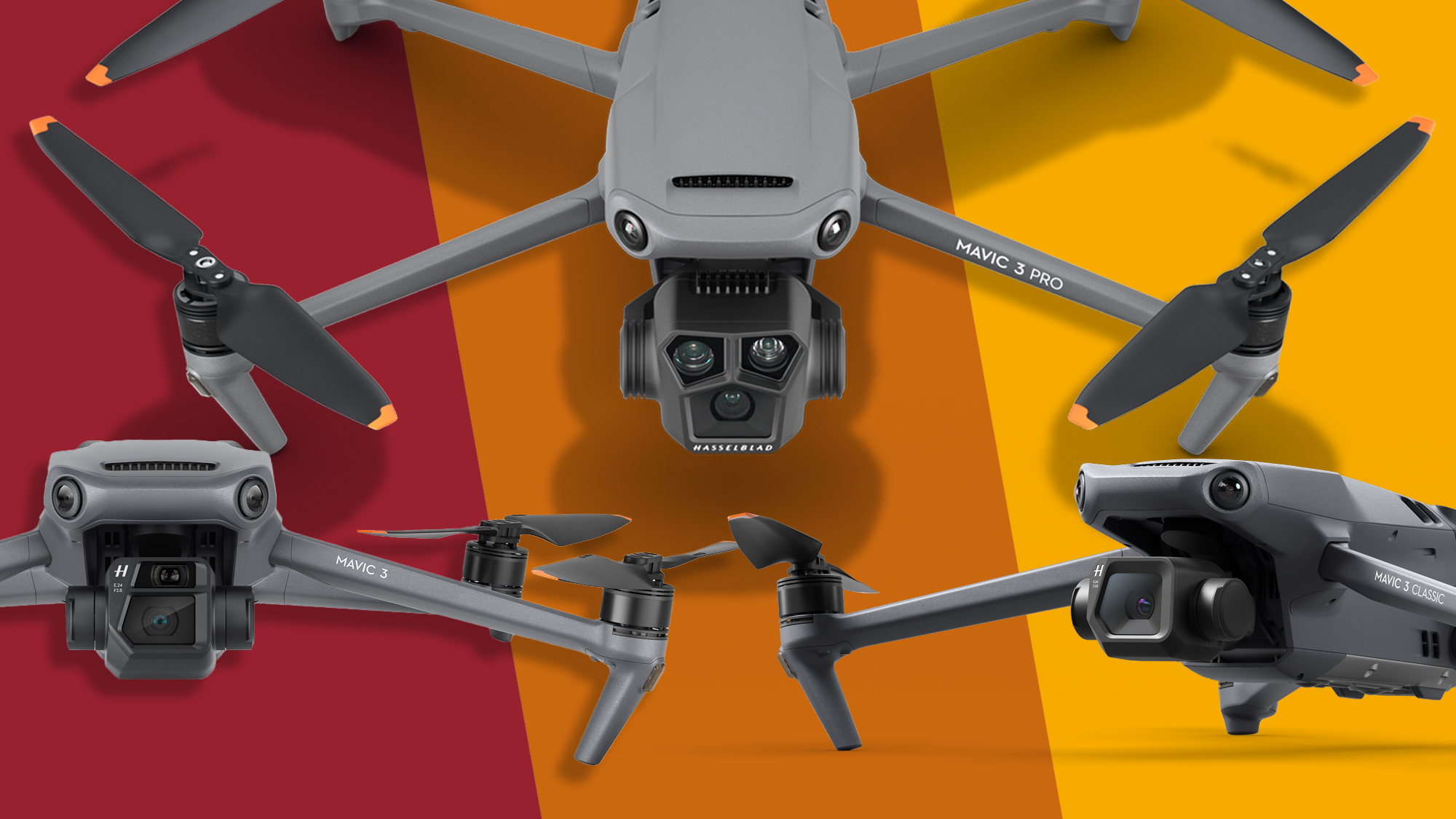
Two camera/lens-incorporating ‘prosumer’ drone option, currently in the process of being retired from sale following the introduction of the newer DJI Mavic 3 Pro.
For
- Excellent image quality and class leading operation
- Adjustable aperture feature
- Telephoto lens a useful backup
- Improved safety features over its predecessor
Against
- Currently being phased out with the introduction of the newer Mavic 3 Pro drone
- The Cine version is/was extremely expensive
New flagship triple camera and sensor incorporating drone option, replacing the existing Mavic 3 model and offering a distinct contrast to the single camera Mavic 3 Classic
For
- Flagship model in the range
- Three-camera set up aids shooting versatility, especially from the same position
Against
- Shorter battery life than the Mavic 3
- Heavier than its predecessor
- Markedly costlier than the Mavic 3 Classic
A single wide angle camera drone that does it all, offering both beginners and more experienced pilots a more affordable means of entry into the Mavic 3 line up
For
- More affordable than the other Mavic 3 models
- Image quality that’s hard to fault
- Safety features are impressive
Against
- Battery life doesn’t live up to manufacturer’s claim
- No telephoto camera
- No Apple ProRes video-capture option
DJI as a manufacturer has in the space of a few short years become as synonymous with camera-incorporating consumer and ‘prosumer’ drones as Hoover has over many decades with vacuum cleaners. Its Mavic series is its flagship range, its products sitting above the mid range Air series and the beginner friendly Mini line up.
It was perhaps inevitable then that its very latest DJI Mavic 3 model would come with a ‘Pro’ suffix. The DJI Mavic 3 Pro follows on from the previously released DJI Mavic 3 and the DJI Mavic 3 Classic, which we’re comparing and contrasting here.
Until now, the slightly simpler Mavic 3 Classic sat below the Mavic 3 and was intended to be the more accessible option in the Mavic 3 line up, while the newer Pro model is, as it sounds, now very much the flagship. Especially as our latest information points to the Mavic 3 being removed from the line up entirely, though sales are continuing while stock remains in the market.
We’re comparing all three of these options here to allow you to make an informed comparison and the purchase choice that’s right for you. Three is, after all, the magic number…
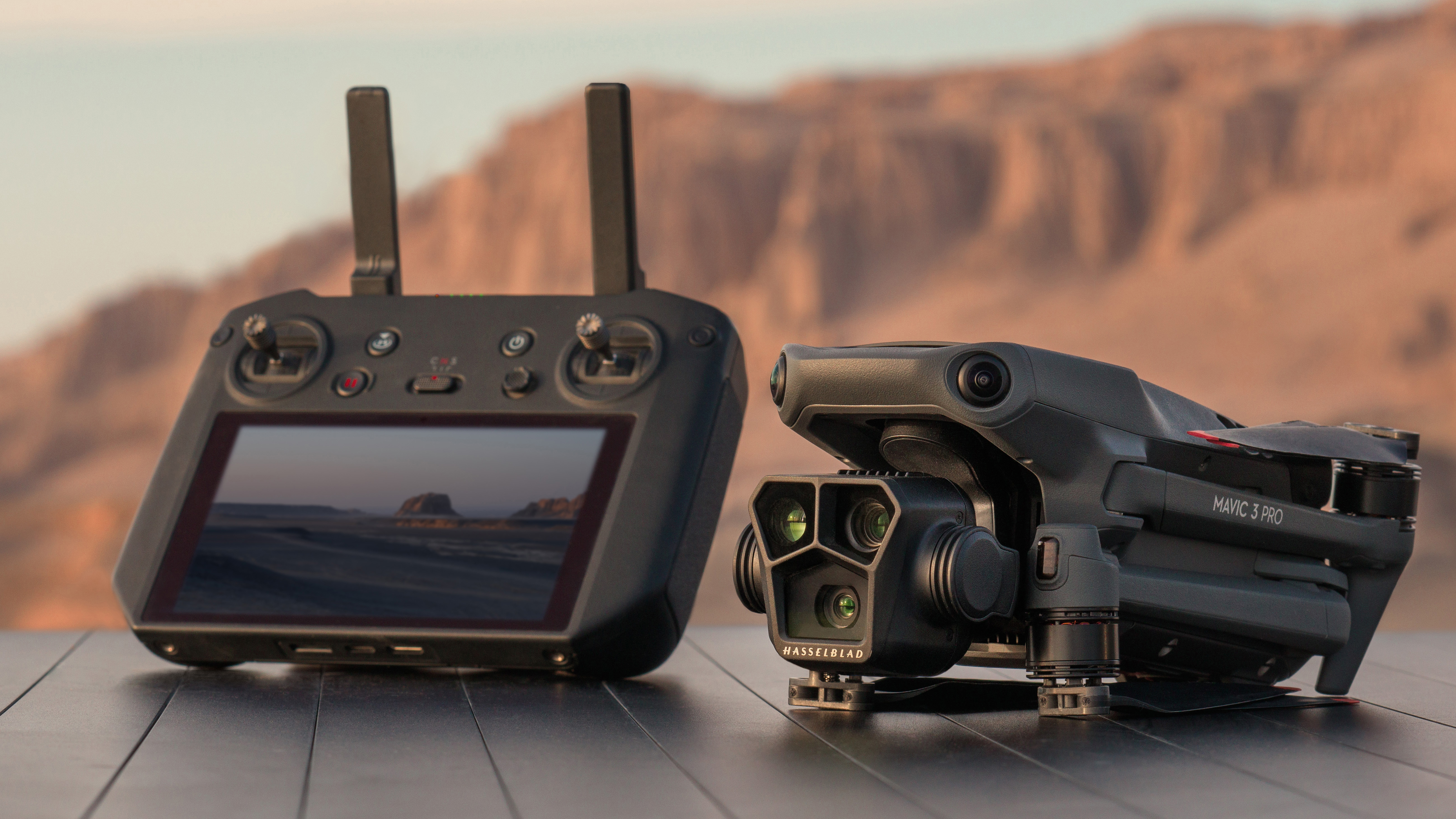
DJI Mavic 3 vs DJI Mavic 3 Pro vs DJI Mavic 3 Classic: Price and Availability
Just announced at the time of writing, the DJI Mavic Pro 3 has a retail price of $2,199 / £1,879 / AU$ 3,099. The alternative is a DJI Mavic 3 Pro Fly More Combo kit option with additional accessories costing $2,999 / £2,549 / AU$ 4,199. The top tier package meanwhile is the DJI Mavic 3 Pro Cine Premium Combo kit, priced at $4,799 / £4,109 / AU$ 6,939.
Examining the above, the older DJI Mavic 3 and the newer Mavic 3 Pro’s pricing is similar, meaning that the Mavic 3 Pro looks like decent value for money from the off.
But, while the Mavic 3 will remain on sale alongside the newer Pro model, we understand that there won’t be any further units of the Mavic 3 produced, even though it will remain on sale ‘while stocks last’. While we may consider the withdrawal of the Mavic 3 a shame, on the plus side with the latest Pro version we’re effectively gaining an extra camera for the same cost.
One slight irritation for prospective Mavic 3 Pro buyers who already own a DJI controller is that there isn’t a ‘body only’ bundle available for the drone on launch. That said, a drone-only option for the Mavic 3 Classic eventually arrived a little down the line. As detailed above, the least expensive option for now is buying the ‘Pro’ with a DJI RC controller for $2,199 / £1,879 / AU$ 3,099.
The aforementioned and more affordable – if still a little expensive – Mavic 3 Classic comes in at $1,599 / £1,399 / AU$ 2,399 for the standard controller kit, with the Fly More kit, essentially a carry bag, two additional batteries, a three battery charging hub and other accessories, costing $649 / £599 / AU$ 799. The drone-only option for the Mavic 3 Classic, aimed at those who already own a compatible controller, is $1,469 / £1,309 / AU$ 2,299.
While we can still find one on sale, the now oldest option of our trio in the Mavic 3 comes in a Standard version and a Cine version, while there’s likewise a Fly More kit option. The Standard Mavic 3 costs $2,199 / £1,879 / AUS$ 3,099, the premium Cine version retails at a sizeable $4,999 / £4,279 / AU$ 7199 – which as we can now see is dearer on its launch than the newer Mavic 3 Pro option is on its debut – while the Fly More kit, which includes what’s provided in Standard version, adds two additional batteries, three additional pairs of propellers, a battery charging hub, and ND filter set and carry bag. This costs $2,999 / £2,549 / AU$ 4199.
So, if one camera is enough, the Mavic 3 Classic offers fair value, though the Mavic 3 Pro in offering three-in-one arguably offers better value, even if being pricier overall.
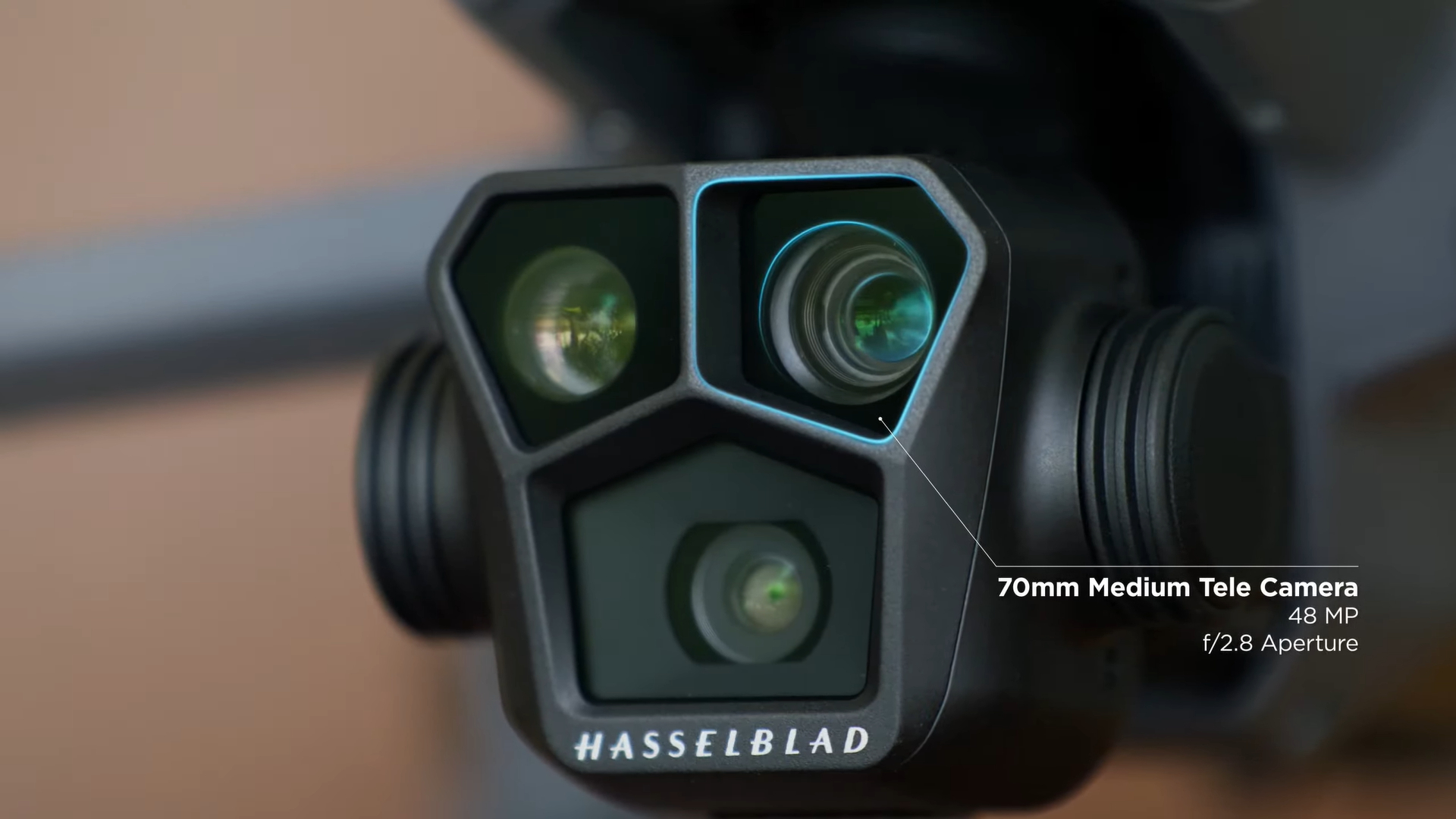
DJI Mavic 3 vs DJI Mavic 3 Pro vs DJI Mavic 3 Classic: Lenses & Sensors
Cutting to the chase, we now have DJI Mavic drones offering three lenses (Mavic 3 Pro), two lenses (Mavic 3, in the process of being phased out) and one single lens (Mavic 3 Classic), the latter still providing a decent option for those who just want high quality wide angle shots for their video presentations (high-end real estate agents for example).
But let’s examine what each offers in this crucial area in more detail.
As predicted in advance of its unveiling, the latest flagship DJI Mavic 3 Pro distinguishes itself by being its maker’s first ever triple-camera incorporating consumer drone. As a result, this also makes it the manufacturer’s most versatile drone at the time of writing. Provided here are a main Four Thirds sensor camera with a wide angle 24mm lens, a 1/1.3-inch sensor camera providing a mid telephoto like focal length of 70mm, plus a third camera boasting a 166mm telephoto setting.
This camera is similar to the one on the DJI Mavic 3 model, complete with the same modest 1/2-inch sensor, yet on a slightly more positive note the one we find on the Pro model has a slightly brighter f/3.4 aperture, compared to its predecessor’s f/4.4. Theoretically this should marginally boost results from the DJI Mavic 3 Pro compared with its siblings when lighting conditions are less than ideal.
That 70mm camera also adds to the DJI Mavic 3 Pro’s versatility, plugging the gap between its wide angle and maximum telephoto options. In essence by having 24mm, 70mm and 166mm lenses in the one device, drone shooters have the possibility of a wide angle establishing shot, a close-up plus b-roll footage, all without having to move the drone, and with a different look and feel to each. A flying equivalent of the world’s best camera phone perhaps, or the equivalent of a photographer or videographer’s kit bag of lenses, without actually needing to change any of them to best suit the subject?
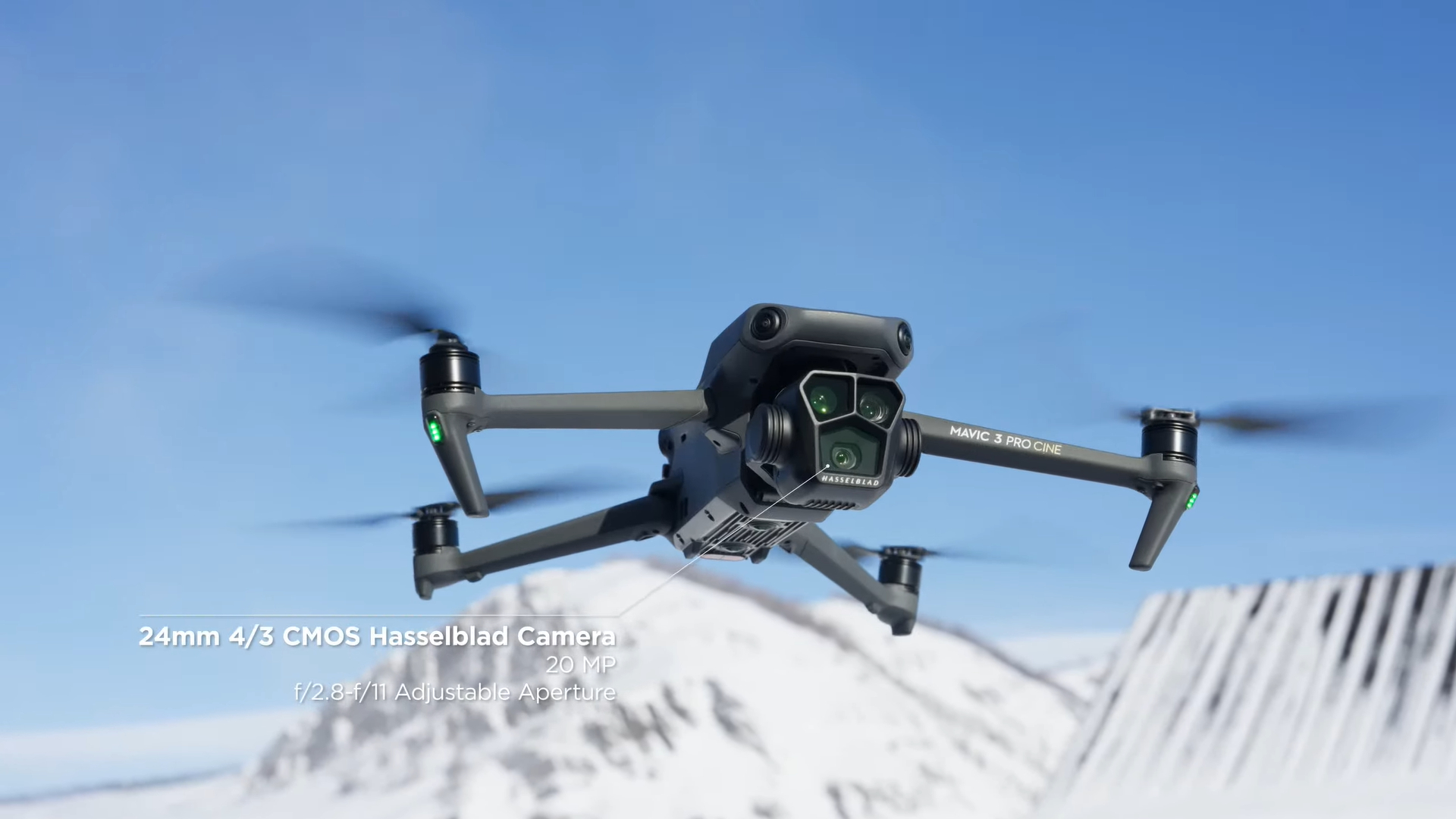
As on any camera, telephoto lenses help isolate the subject from its background and really bring what we intend to be the main focus to the fore – which is perfect for any budding wildlife cameraman. Since its classification as a Class 2 drone means we can’t fly it that close to people, the Pro’s two telephoto lenses may come in useful in us not actually having to, and still be able to capture the footage we want.
Camera and sensor wise, the main difference between the original Mavic 3 and the Classic, meanwhile, is that the former has a Four Thirds sensor twinned with a 162mm telephoto lens, while the Classic, in making do with the one 24mm lens, doesn’t have this telephoto option. Instead of two or three lenses and sensors combining, we’re reliant with the Classic on just the single Hasselblad 20MP 4/3 camera with admittedly bright-ish maximum f/2.8 aperture. Apart from the differing camera set up, looks and design wise the Mavic 3 Classic is remarkably similar to the Mavic 3.
By contrast then, the big selling point on the introduction of the Mavic 3 was its dual Hasselblad camera set up. The main camera features a 20-megapixel Four Thirds CMOS sensor and the ability to adjust the aperture in use between f/2.8 and f/11, arguably providing the best image quality in its class on launch. The drone’s second telephoto lens is more limited in operation, lacking manual control or the ability to shoot in Raw, but proves a useful alternative for the capture of more distant subjects, or indeed close ups. The second camera comprises a 1/2-inch CMOS sensor with an equivalent focal length of 162mm, a fixed f/4.4 aperture plus a 28x hybrid zoom.
So, in summary, the camera set up of the Mavic 3 is more versatile than the Mavic 3 Classic, but both now pale in comparison with the ‘triple threat’ provided by the newer Mavic 3 Pro.
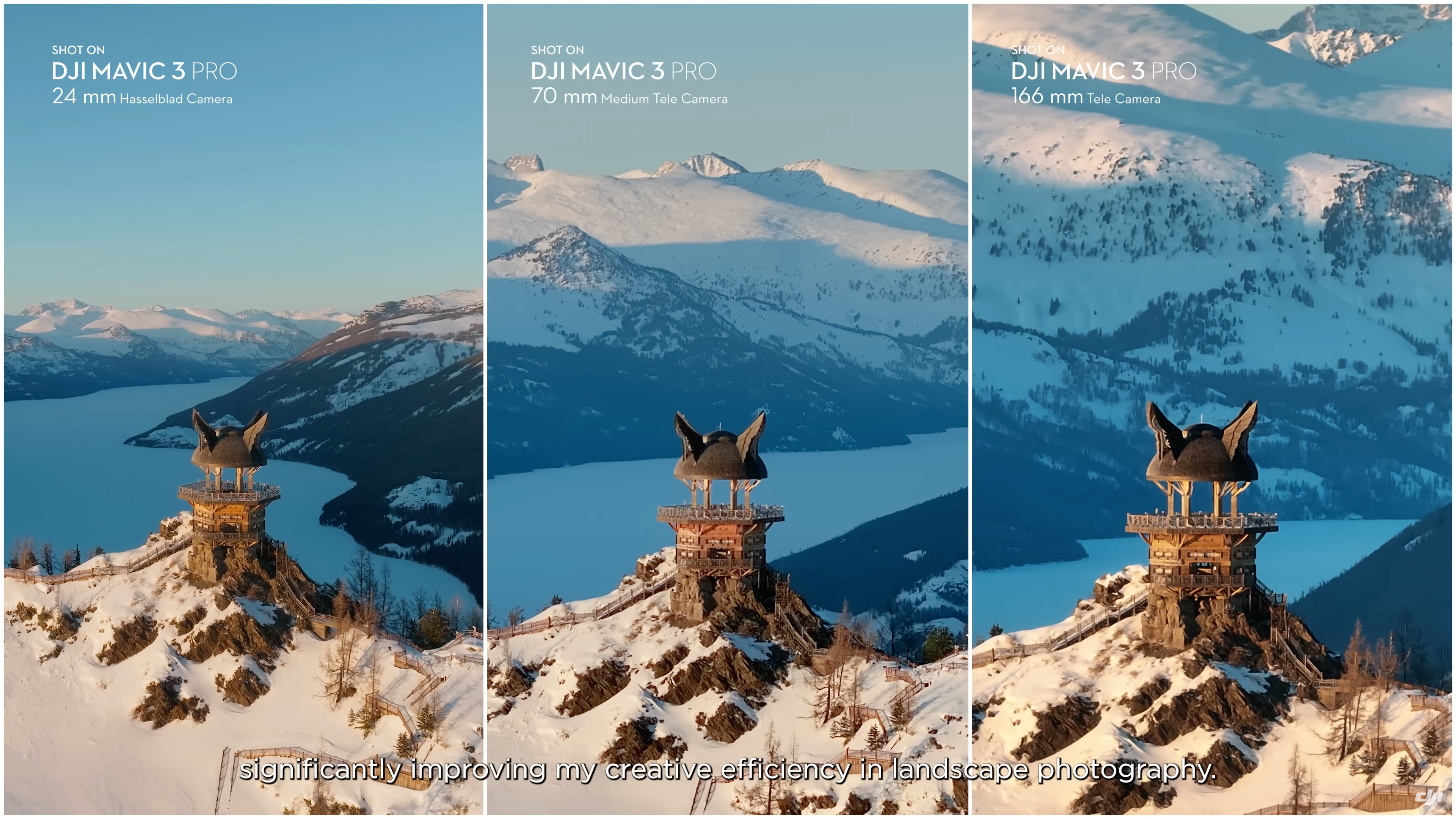
DJI Mavic 3 vs DJI Mavic 3 Pro vs DJI Mavic 3 Classic: Video
The latest DJI Mavic 3 Pro’s main camera is capable of capturing 5.1K resolution video at a frame rate of 50fps, or 4K-resolution footage at 120fps for slow motion playback. However, its ActiveTrack autofocus feature is not available when shooting at resolutions higher than 4K, or at frame rates above 60fps.
The medium telephoto 70mm lens camera, when combined with its 1/1.3-inch sensor, is capable of shooting 4K-resolution video at 60fps, or 48 megapixel still images, as desired. Support is provided here for DJI’s new D-log M format that’s claimed to be a versatile option for colour grading. As with the Mavic 3 drone, only the Cine version of the Pro supports the Apple ProRes lossless video format however.
While the Pro offers a big improvement over just using the digital zoom on the Mavic 3’s main camera, and the 166mm telephoto lens on the Mavic 3 Pro has a brighter f/3.4 aperture than the Mavic 3, its video quality will still be limited to an extent by its 1/2-inch sensor size.
As on the DJI Mavic 3 model, the Mavic 3 Pro boasts DJI’s O3+ transmission system which purports to deliver a 1080P/60fps HD live feed at distances of up to 15Km for the USA, and 8Km elsewhere. These are theoretical distances however, as most laws require drone users to maintain a line of sight with their device.
It’s worth noting that slow motion footage can’t be captured on the Mavic 3 Pro when using the 70mm or 166mm focal lengths, just when employing the main 24mm equivalent camera.
While the currently-in-the-process-of-being-retired Mavic 3 and the Mavic 3 Pro offers the option of Apple ProRes recording, the Mavic 3 Classic, in being the lower priced option in the series, does not. That’s a shame, as it’s a software not a hardware based decision.
While that omission on the Classic may prove a deal breaker for some professional videographers, many will find that video capture up to 5.1K in Normal, HLG (hybrid log-gamma high dynamic range) and 10-bit D-Log profiles at 200MBps more than make up for it. Its camera can still capture 12-bit Raw files plus JPEGs of excellent quality, with the Mavic 3 Classic capable of slow motion 120fps capture in cinematic looking 4K, if the user desires. There are also options to shoot up to 5.1K at 50fps and Full HD video at up to 200fps.
As with the newer Mavic 3 Pro, potential purchasers of the Mavic 3 were offered Standard and Cine versions on launch, with the main difference between the two being the Cine version offering a much more generous built-in 1TB SSD of storage, rather than 8GB of internal storage. If needing the ability to shoot Apple ProRes, the Cine option is the one to go for. Otherwise the essential headline features are that like the Mavic 3 Classic it can shoot 5.1K video up to 50fps, C4K at up to 120fps, Full HD up to 200fps when using the H264/H.265 codecs, plus has the ability of FHD up to 120fps when shooting Apple ProRes. Up until the introduction of the Mavic 3 Pro, we reckoned the Mavic 3 was undoubtedly the best ‘prosumer’ drone that could be bought – at a price. Now the Mavic 3 Pro inherits that mantle, with the Mavic 3 Classic sitting beneath.
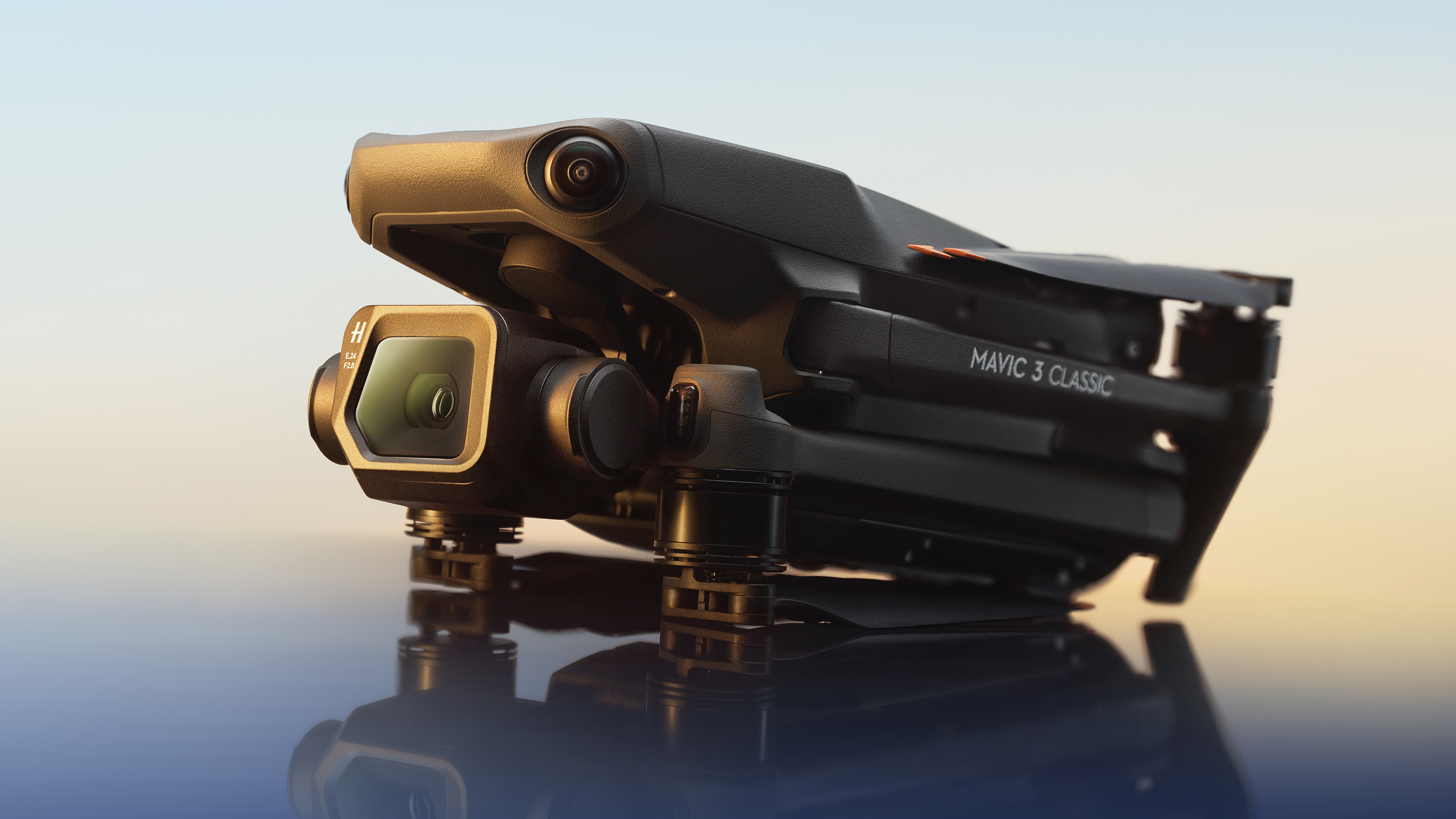
DJI Mavic 3 vs DJI Mavic 3 Pro vs DJI Mavic 3 Classic: Build & weight
Thanks to its three camera ‘payload’ and bigger camera module in general, the DJI Mavic 3 Pro is unsurprisingly a little heavier than its now ‘retired’ Mavic 3 forebear, resulting in the newer device being classified as a ‘C2 class’ drone in Europe.
In practice this means that it will need to be flown at least 50 metres away from people. However it is still pretty compact when folded down, making it a good ‘travel drone’ option. That said it isn’t the prettiest drone we’ve ever seen, even if its refinements make it a great alternative to the likes of Autel and Skydio.
The alternative current Mavic 3 series option in the single camera Mavic 3 Classic weighs a very manageable 895g, making it also an excellent travel drone option for those for whom the single camera will suffice.
Essentially the Mavic 3 Classic features an identical design to the Mavic 3, both measuring 221x96.3x90.3mm folded or 347.5x283x107.7mm unfolded, while the two established drones also weigh the same. Except, that is, if plumping for the Mavic 3 Cine version, which weighs in at 899g. The Mavic 3 is however lighter than the Mavic 2 Pro, which weighed 907g on launch. Inevitably the triple-camera Mavic 3 Pro is heavier than both at 958g, which won’t be a surprise to anyone. Folded dimensions are 98x95.4x231.1mm, while unfolded the flagship is 290.8x107.7x347.5mm.
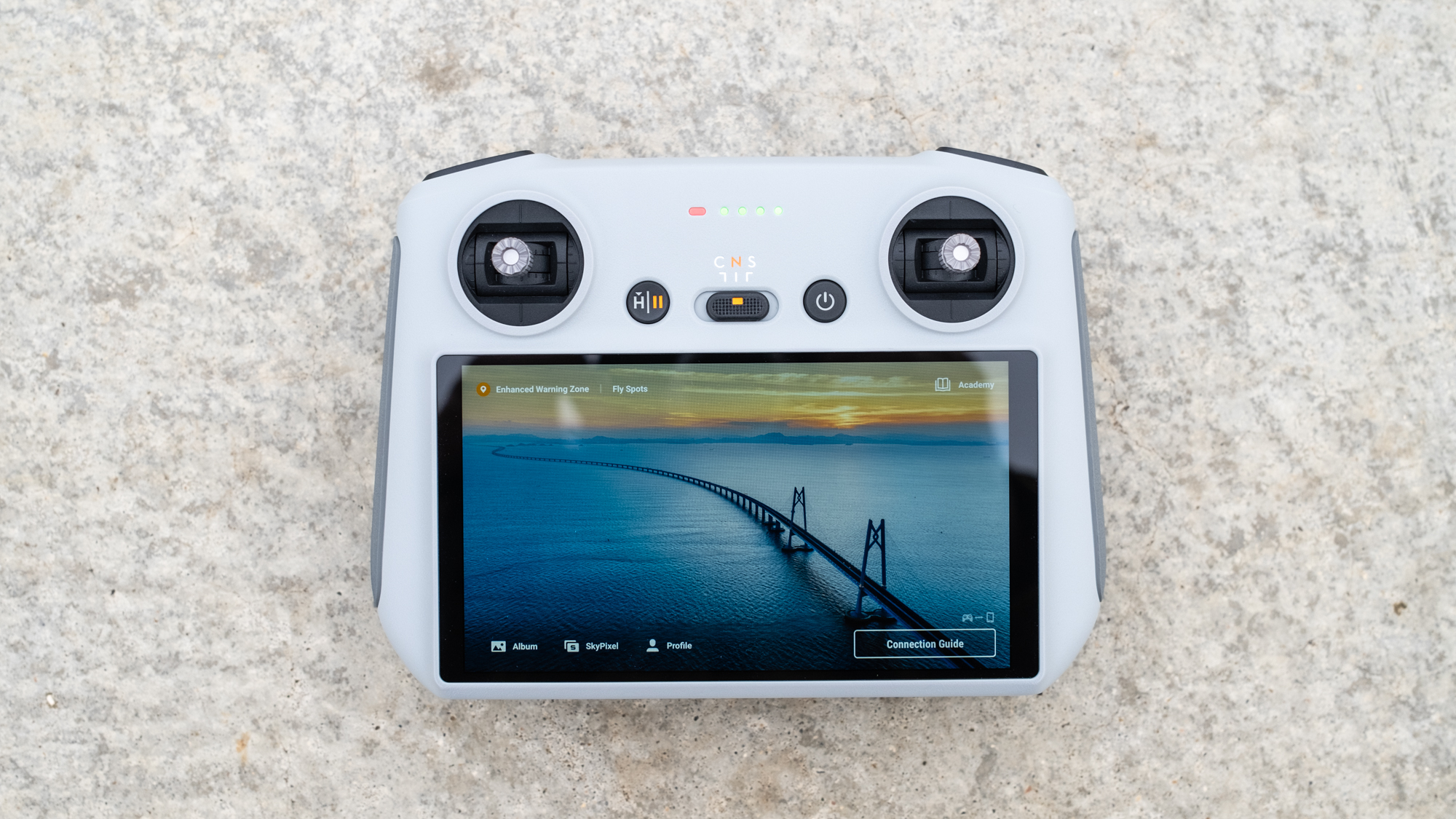
DJI Mavic 3 vs DJI Mavic 3 Pro vs DJI Mavic 3 Classic: Battery life & additional features
The DJI Mavic 3 Pro’s battery life at a claimed 43 minutes is slightly shorter than both the Mavic 3 and Mavic 3 Classic. By contrast, the Mavic 3 and the single camera Mavic 3 Classic’s battery life is said to be good for 46 minutes of flight time, although on test we found the battery life of both drones was in fact shorter than claimed; an average flight time of around a half hour was more realistic in practice. We’d wager we’ll be looking at a performance similar to half an hour for the DJI Mavic 3 Pro.
When in flight, the Pro model also has the same obstacle avoidance system as its Mavic 3 predecessor. Eight wide-angle sensors are designed to work seamlessly to help the device avoid tree branches and other obstructions when flying.
Although the most affordable option of the three drones, the Mavic 3 Classic is similarly no slouch in offering all of the flight and safety features we’ve come to expect.
These include APAS 5.0 collision avoidance, ActiveTrack 5.0 for subject tracking, GEO 2.0 geofencing, Advanced Return to Home, which scans up to 200m in all directions for the safest and most efficient route back to takeoff point, plus Quickshots automated flight patterns.
With all this on board the Mavic 3 Classic couldn’t/shouldn’t be classed as a beginner drone. But with such advanced flight and safety features nevertheless both beginners and experienced pilots alike can confidently fly the Classic. It has a European C1 certification, in contrast to the Mavic 3 Pro’s C2 classification, meaning no training is required for the Classic model even if we do have to complete an exam defined by our local aviation authority.
Punching above its weight the Mavic 3 Classic has a wind speed resistance of just under 27mph, and in practice we found the drone was able to fly comfortably against the wind in Normal mode and capture smooth looking video. This is extremely useful when recording footage in open countryside without the wind protection offered by surrounding buildings or structures. It has three flight modes with differing speeds and functionality, with ‘Sports’ offering a top 47mph speed. However collision avoidance is disabled in this top mode, so it's not the best option for flying in more complex environments. Cine mode by contrast offers the slowest flight speed.
The Mavic 3 likewise also boasts a maximum 47mph speed in Sports mode, and in terms of its safety features employs multiple vision sensors to ‘see’ obstacles in all directions, again extended up to 200m in all directions when Advanced Return To Home functionality is initiated. It additionally boasts an Advanced Pilot Assistance System (APAS) 5.0, which combines six fisheye sensors and two wide-angle sensors to sense obstacles in all directions; enabling the drone to fly autonomously around detected obstacles, maintain continuous flight or to brake.

Which one should I buy?
Ultimately, with the current Mavic 3 stopping production, the obvious longer-term choice for drone enthusiasts will be between the triple camera DJI Mavic 3 Pro and the single camera DJI Mavic 3 Classic, the latter being the more affordable option of the two and still one of the best drones available in its class.
However, the creative and practical versatility provided by the three camera set up of the Mavic 3 Pro – not to mention the hours of fun to be had – means that the new flagship is shaping up to be one of the very best drones we can buy.
The trade off is slightly less battery life, a heavier weight because of that additional camera and the fact that its C2 classification means that we’ll need to fly it at least 50 metres away from people.
Whichever of the three Mavic drones we opt for though, we can be sure we’ll be rewarded with years of service.







